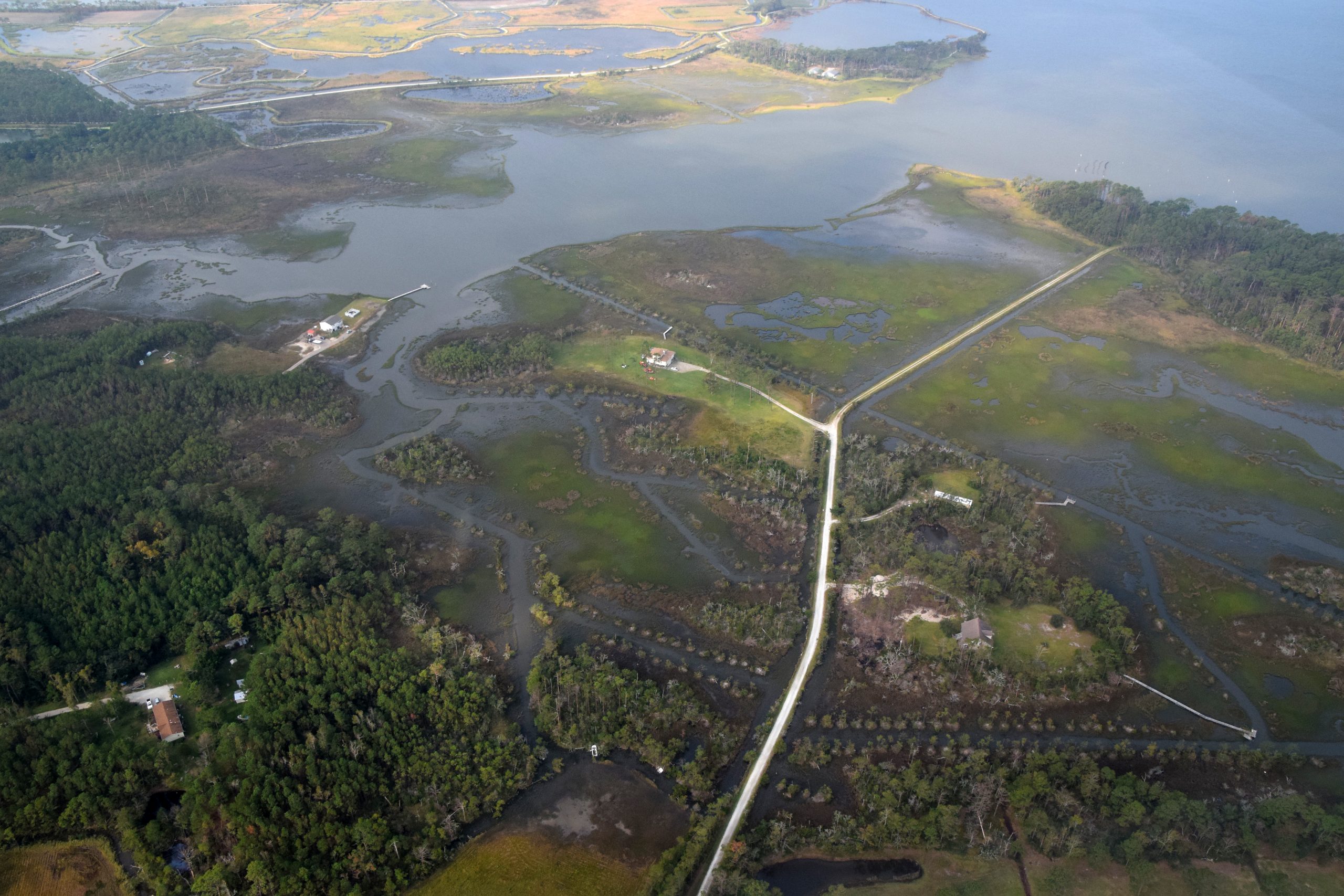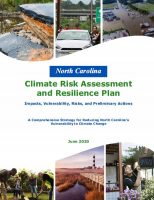
Last year, a Coastal Review series for the Pulitzer Center’s Connected Coastlines initiative looked at how hurricanes, floods, nor’easters and other major events in recent years significantly dampened any remaining skepticism on the science of climate change.
In this first installment of our latest series supported in part by the Pulitzer Center, we look at how that shift in the debate is changing public policy and what kinds of plans and possible solutions are taking shape.
Supporter Spotlight
The 2020 Atlantic hurricane season, the most active on record, ended without a major storm, but many communities still reeling from storms of previous seasons continue to struggle to repair and recover.
 The relentlessness of tropical storms and severe weather over the past half-decade has changed the dialogue on climate change statewide. State policy has shifted, too, but slowly and unevenly. While there’s consensus about some actions to further protect communities and make them more resilient, leaders are still divided when it comes to other climate-related initiatives such as greenhouse gas reduction.
The relentlessness of tropical storms and severe weather over the past half-decade has changed the dialogue on climate change statewide. State policy has shifted, too, but slowly and unevenly. While there’s consensus about some actions to further protect communities and make them more resilient, leaders are still divided when it comes to other climate-related initiatives such as greenhouse gas reduction.
In June 2020, Gov. Roy Cooper released the North Carolina Climate Risk Assessment and Resilience Plan, an extensive 372-page report on what the science is saying about North Carolina’s present and future, the state’s many vulnerabilities and an extensive set of strategies to address climate-related hazards.
The report followed through with a strategy Cooper launched early in his term to combine the effort to build resiliency with an emissions-reduction strategy organized around green energy.
A brief history
In the wake of destructive hurricanes in recent years, record rainfall in 2018, and sporadic, prolonged droughts, there was broad consensus around the need for resilience, a catch-all term that now seems to encompass every strategy aimed at weathering future storms.
Supporter Spotlight
The consensus on resilience has been strong enough to draw significant state funding and lead to policy changes, despite the backdrop of long-running political disagreements and budget standoffs between Cooper and leaders in the North Carolina General Assembly.
The most concrete result of the resiliency consensus is a new state agency, the Office of Recovery and Resiliency, which was formed in late 2018 to manage the massive flow of federal funds coming in the wake of the storms.
In contrast to at least a general agreement on the need to build resilience, the difference between the governor and legislative leaders on climate change mitigation, particularly limits on fossil fuels, could not be starker.
The General Assembly began the 21st century with an eye on a less carbon-reliant energy policy, passing requirements for renewable energy generation and forming a commission on global climate change to develop a state action plan.
After a series of delays and over industry objections, the commission released a 117-page report in 2010 calling for a major statewide effort to reduce emissions.
The year the report came out, Republicans won majorities in the state House and Senate and the leadership of key committees shifted to legislators openly skeptical about the science around climate change.
At the same time, lawmakers and administration officials were being courted by oil and gas exploration companies who saw potential for renewing offshore exploration as well as hydraulic fracturing — fracking — for natural gas in Piedmont shale deposits.
Within a year, the legislature embraced both onshore fracking and offshore drilling. A sweeping energy policy bill passed in 2011 declared that both industries would bring jobs and oil and gas royalties to the state.
In 2012, the legislature launched its notorious effort to limit the science used to determine the rate of sea level rise, and the legislature eventually codified skepticism of any science based on models showing an accelerated rate of sea level rise.
The legislature had a willing partner from 2013 to 2016 in then-Gov. Pat McCrory, who enthusiastically supported fracking and offshore drilling.
But McCrory’s defeat in 2016 by Cooper led to a change in the executive branch every bit as striking as the legislature’s shift in 2011, starting with unvarnished opposition to a Trump administration plan to reopen the leasing program for oil and gas exploration along the Atlantic Coast.
In October 2018, Cooper followed through on a campaign promise to reduce the state’s carbon emissions through Executive Order 80, which signed on to the 2015 Paris Agreement on climate change, and mandated a full review of state government policies and operations to reduce greenhouse gas output.
The order was significant because in addition to calling for numerous concrete steps across state government, it also knit together the concepts of climate change resilience and mitigation. The last “whereas” in the document reads:
“Whereas to maintain economic growth and development and to provide responsible environmental stewardship we must build resilient communities and develop strategies to mitigate and prepare for climate-related impacts in North Carolina.”
A different kind of plan
Coastal Review talked with four longtime state environmental policy experts about the Climate Risk Assessment and Resilience Plan, what it means and whether the governor and the legislature can bridge divides on key issues.
Cassie Gavin, director of government affairs with the North Carolina Sierra Club, said the decision to combine resiliency and climate change mitigation into the state’s strategy is a significant step forward, addressing both cause and effect.

“They have to go together. I’m glad that they are and that the state is doing both things at the same time,” she said. “The plan is a good start in that it sets a path for state agencies and local governments to follow and lays out resiliency priorities that the legislature should fund.”
She said it also gives local governments a template to work from in developing their own plans. It includes a scoring system for qualifying risk and other strategies that local governments can use.
“It’s not just the state that needs a resiliency plan,” Gavin said, “every community, especially at the coast or any community near water, needs a resiliency plan of their own.”
Bill Holman, state director of The Conservation Fund and a former state environmental secretary, said North Carolina has suffered from the lack of a long-term resiliency plan.

“Unfortunately, we have a lot of experience dealing with major floods going back more than 20 years,” Holman said. “I think what we’ve lacked is that while we’ve responded to the storms, we really haven’t done much to make ourselves more resilient for the next storm.”
Many communities would like to take action but need technical and financial support from the state to move forward, he said. Success in those communities would likely spur change in other places.
“I’m an optimist about the long haul here, because it’s an imperative and we really don’t have a choice, in particular in eastern North Carolina, where becoming more resilient is going to be critical to its long-term environmental and economic health.”
The choice for many places, he said, will be to become more resilient or wither away.
Will McDow, Resilient Landscapes director for the Environmental Defense Fund, said he agrees that the report could provide a pathway for communities looking to be proactive.
“It does a good job of providing that North Star, providing those guiding principles for where the state should go,” he said.

Attitudes among once-skeptical farmers and residents in rural, eastern North Carolina are changing, he said, and elected officials are beginning to get the message.
“There’s a shift in how people are thinking. They may not believe the science, but they believe their eyes. They’re seeing longer droughts and they are seeing higher flood waters, and that’s beginning to trickle up.”
One concept that’s resonating is using natural and working land to increase resilience capacity, a key part of the plan.
In one of the last bills passed in 2020 legislative session, the General Assembly approved a plan to create an inventory of areas where floodwaters could be diverted to reduce effects on towns and infrastructure downstream.
The bill also expands the Department of Environmental Quality’s Division of Mitigation Services to include natural-based solutions for flood mitigation in its grant program and to work with private landowners to provide floodwater capacity.
“Natural infrastructure is going to be a critical component of building the resilience of eastern North Carolina. It’s going to differ by watershed and it’s not a silver bullet, but it’s important,” McDow said. “Resilience is going to take a lot of different actions, diversity in all its different forms. There are going to be places where buyouts and getting people out of harm’s way are going to be a critical part of the conversation. There may be places where levees are actually needed or other gray infrastructure, but for the most part finding ways to make our landscapes more spongy is a critical piece of how we’re going to absorb more water when it comes.”
McDow said the climate report’s strong emphasis on environmental justice and bringing more voices into the conversation are also critical, because of the realities of the region.
The plan devotes a major section to a climate justice strategy, breaking down how aspects of climate change disproportionally affect already vulnerable communities.
It calls for the state to step in with funding and expertise for local communities that don’t have the resources, along with greater effort to add more local voices to the discussion and support locally initiated efforts.
“Historically, resilience efforts have not engaged organizations that interface most frequently with socially vulnerable populations, such as public schools, social service and healthcare providers, houses of worship, faith-based organizations, and public transit systems. These kinds of organizations could be the basis of very successful resilience efforts in the future,” the report states.
“This is the place where more conversation is needed,” McDow said. Policy decisions, he said, must be based on a community’s needs and what solutions are going to work for them.

“Resilience is more than flooding, it’s other longstanding impacts, water pollution, air pollution, economic disinvestment, there’s a lot of aspects to be thought about here, not just the flooding,” he said. “It’s got to be informed by those lived experiences.”
Grady McCallie, policy director for the North Carolina Conservation Network, said there’s broad recognition that low-wealth communities and communities of color in flood-prone areas that are hit repeatedly could get the biggest benefit from resiliency planning. But at the same time, they are often the communities that can least afford the planning and engineering costs that go into proposals.
“If you look at traditionally marginalized communities, they have the least ability to do those kinds of plans ahead of time, so that when the next big slug of money comes around, they don’t have anything ready to go and don’t have competitive applications put in.”
Looking forward
McCallie said the new plan has several important features: it establishes a baseline science on climate change; carries forward resiliency planning throughout state government; and looks to build resiliency in local communities. But without follow-through and without additional support from the legislature, he said, it will only go so far.
“The initiative on climate is all coming from the executive branch right now,” he said. “We need it from the legislative branch and legislative leaders are not leading on climate. There’s a lot of stuff that the executive branch can do and is doing, but there’s a lot that only the legislative branch can do.”
The most important step, he said, would be for the General Assembly to set up a reliable funding stream for resilience, particularly for planning at the state and local levels.
“Resiliency needs a stable, long-term funding source,” he said.
Holman said planning funds are important because having plans in place and a set of shovel-ready projects puts states in a better position to draw down federal support after major storms. He said Florida and the Chesapeake Bay region states have been able to tap federal funds from natural solutions because of forward planning and that’s allow them to suck up federal funds following major storms that could have gone to projects here.
“We’ve been missing out on money for natural solutions,” he said. “Some states were ready to go after those funds and some were not.”
McCallie said that, so far, there seems to be commitment to keep moving forward with Jeremy Tarr, the governor’s main policy adviser on resiliency and climate change, now leading an interagency working group on implementing the plan.
“If all they had done is put out this giant report, we’d be concerned about how it’s going to get implemented, but we’re really glad to see this commitment to staffing,” he said.
That’s important, McCallie said, because the buy-in across state government isn’t the same, and one criticism of the plan is that it is uneven, varying from department to department. “It’s evident some agencies thought deeper about it.”
While there are some steps the state can take now, the degree of meaningful follow-through on the plan and the ideas and challenges it raises will depend how much of it takes root in the legislature. Changes beyond what the executive branch can do, including additional funding and significant changes to law and policy, require legislative participation.
Given the political headwinds and the focus on pandemic response and recovery that could prove difficult.
Gavin said whether that changes and how fast it changes will determine how soon we see a difference in policies and funding on climate issues. So far, she said, climate change has far outpaced the General Assembly.
“The political process has been much too slow for the reaction that we need to see to address climate change in a meaningful way,” she said.
Next in the series: Helping underserved communities







